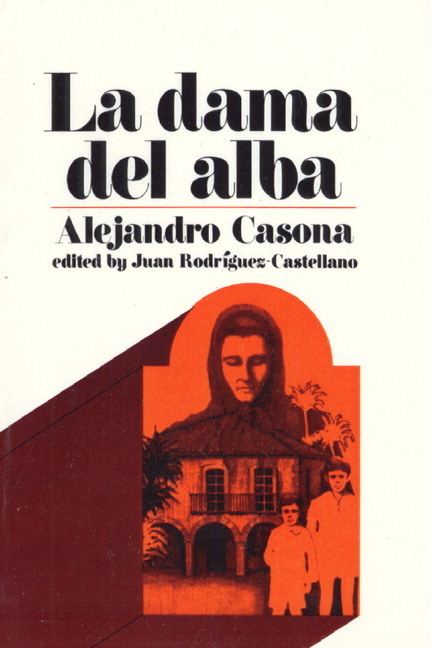Originally published 1947 | ||
 | ||
Similar Works by Alejandro Casona, Other books | ||
La dama del alba alejandro casona
La dama del alba ("The Lady of the Dawn" in English) is a Spanish play, very popular in its own country, written by playwright Alejandro Casona in 1944. It is a fantasy-drama in which Death personified is the main character. It takes place in a small village in the Spanish Principality of Asturias. The play consists of four acts.
Contents
- La dama del alba alejandro casona
- Act I
- Act II
- Act III
- Act IV
- Film versions and opera adaptation
- References
Act I
The Narces family is introduced in this act. It is revealed that the mother mysteriously lost a daughter, Angelica, to the large river in their town four years ago. Angelica was married to a young man named Martin three days before her apparent death. Her body was never found, and thus no proper burial was performed. The memory of her death still dwells in the minds of her family. The play starts on the anniversary of her death. La Peregrina (The Pilgrim in English) shows up at the door, who is traveling on the Camino de Santiago, or "Way of St. James," as it is translated into English. Since pilgrims are said to bring blessings upon the houses they visit, the family allows her inside. The grandfather recognizes her but doesn't remember from where he knows her. The children play a game with her, and she laughs in a strange way, which scares the children. She says she has never laughed before. She is also surprised by the fact that she had felt her beating heart. Suddenly, the lady becomes fatigued and falls asleep. She tells the children to wake her up before nine, which they fail to do because they go to bed.
Act II
The Grandfather realizes that La Peregrina is the personification of death; he recognizes her from a near-death experience he had years before in the mine accident which killed all the children of the family servant, Telva. He pleads with her to leave his family alone, as they have suffered enough already because of her. The pilgrim had actually come to kill Martin but was unable to, because she was asleep when Martin was supposed to die. Death—who is described in very human terms in the play—explains she is merely fulfilling her mission, and doesn't like having to be present whenever someone dies. La Peregrina explains to the grandfather she has a difficult life, never being able to die yet being death itself. The grandfather takes pity on her referring to her as a "poor woman." Meanwhile, Martin brings back a girl by the name of Adela, who had tried to commit suicide in the river. The pilgrim lady admits that she wasn't expecting the young girl's death. Even so, she says that Adela will again search for her (death), and next time she will find it. The grandfather is told by the pilgrim that he and the family will be happy at her return despite the fact that when she returns in seven months, it will be to take the life of Adela.
Act III
Adela becomes part of the family, unwittingly beginning to take the role that Angelica had once had, as daughter, lover, and sister. She tries to make the mother happy by wearing Angelica's clothes and trying as much as possible to appear to be Angelica. Martin reveals two secrets. The first secret he discloses is that Angelica was not dead; she had run away with a lover. Martin knew this, but allowed the family to believe she was dead so as not to ruin their memory of her. In addition to this, although he has been rough and has not spoken very much to Adela, he is really in love with her. Martin also describes the town's dislike of Adela, whom they believe is trying to take what was rightfully Angelica's, and trying to take away Angelica's husband. He decides that he must leave to protect Adela from the town's anger, but later decides to act against it.
Act IV
Angelica comes back during the festival of San Juan, unbeknownst to her family. She has been miserable because her lover has long since left her. Ashamed of her actions, she wants to resume her previous life, just the way she left it. La Peregrina tells her that is not possible: she has already been replaced by Adela. The pilgrim realizes her true mission: she has been sent for Angelica. It is Angelica's proper time to die; she must join the pilgrim in the river (that is, drown herself) in order to preserve her image and prevent any shame from being brought upon the family. When Angelica's body is found, seemingly perfectly preserved after supposedly being dead for years, the mother announces that it is a miracle. An appropriate burial is finally held, allowing her family to finally deal with her death. The pilgrim then leaves, commenting on how she envies mortal existence and love.
Film versions and opera adaptation
La Dama del Alba has been filmed at least four times: in 1950 and 1966 for movie theatres, and three times for television, perhaps even more. [1] The 1966 film version featured Dolores del Rio as La Peregrina. [2] There has also been a made-for-TV French version. [3] The play is little-known in English-speaking countries, and has never been filmed in English.
The play has been adapted into an opera by Slovak composer Bartolomej Urbanec (as Pani úsvitu), which premiered in the Slovak National Theatre, Bratislava, in 1976.
